LoRaWAN Metering Infrastructure Planning in Smart Cities
Abstract
1. Introduction
2. Related Works
3. Materials and Methods
3.1. LoRaWAN Technology Overview
3.2. Radio Transmission Range Modeling
3.3. Clustering Techniques
4. New Proposals and Results
4.1. K-Means-Based Gateway Deployment
4.2. Spreading Factor Optimization
| Algorithm 1 SFArrangement |
Parameters: .
|
4.3. Node Deployment Based on Real Geospatial Data
5. Conclusions
Author Contributions
Funding
Institutional Review Board Statement
Informed Consent Statement
Data Availability Statement
Conflicts of Interest
References
- Silva, B.N.; Khan, M.; Han, K. Towards sustainable smart cities: A review of trends, architectures, components, and open challenges in smart cities. Sustain. Cities Soc. 2018, 38, 697–713. [Google Scholar] [CrossRef]
- Dell’Isola, M.; Ficco, G.; Canale, L.; Palella, B.I.; Puglisi, G. An IoT integrated tool to enhance user awareness on energy consumption in residential buildings. Atmosphere 2019, 10, 743. [Google Scholar] [CrossRef]
- Abbas, S.; Khan, M.A.; Falcon-Morales, L.E.; Rehman, A.; Saeed, Y.; Zareei, M.; Zeb, A.; Mohamed, E.M. Modeling, simulation and optimization of power plant energy sustainability for IoT enabled smart cities empowered with deep extreme learning machine. IEEE Access 2020, 8, 39982–39997. [Google Scholar] [CrossRef]
- Mursid, S.; Santoso, H. Analysis of the Effectiveness of the Utilization of Power Monitoring Devices in Reducing Electric Energy Consumption. J. Phys. Conf. Ser. 2019, 1364, 012055. [Google Scholar] [CrossRef]
- Musznicki, B.; Piechowiak, M.; Zwierzykowski, P. Modeling Real-Life Urban Sensor Networks Based on Open Data. Sensors 2022, 22, 9264. [Google Scholar] [CrossRef] [PubMed]
- Shabbir, N.; Hassan, S.R. Routing Protocols for Wireless Sensor Networks (WSNs). In Wireless Sensor Networks; Sallis, P., Ed.; IntechOpen: Rijeka, Croatia, 2017; Chapter 2. [Google Scholar] [CrossRef]
- Mehmood, G.; Khan, M.Z.; Bashir, A.K.; Al-Otaibi, Y.D.; Khan, S. An Efficient QoS-Based Multi-Path Routing Scheme for Smart Healthcare Monitoring in Wireless Body Area Networks. Comput. Electr. Eng. 2023, 109, 108517. [Google Scholar] [CrossRef]
- Almuhaya, M.A.M.; Jabbar, W.A.; Sulaiman, N.; Abdulmalek, S. A Survey on LoRaWAN Technology: Recent Trends, Opportunities, Simulation Tools and Future Directions. Electronics 2022, 11, 164. [Google Scholar] [CrossRef]
- Leonardi, L.; Lo Bello, L.; Patti, G.; Pirri, A.; Pirri, M. Simulative Assessment of the Listen before Talk Adaptive Frequency Agility Medium Access Control Protocol for LoRaWAN Networks in IoT Scenarios. Appl. Syst. Innov. 2023, 6, 16. [Google Scholar] [CrossRef]
- Peruzzi, G.; Pozzebon, A. Combining LoRaWAN and NB-IoT for Edge-to-Cloud Low Power Connectivity Leveraging on Fog Computing. Appl. Sci. 2022, 12, 1497. [Google Scholar] [CrossRef]
- Leonardi, L.; Lo Bello, L.; Patti, G.; Pirri, A.; Pirri, M. Combined Use of LoRaWAN Medium Access Control Protocols for IoT Applications. Appl. Sci. 2023, 13, 2341. [Google Scholar] [CrossRef]
- Noreen, U.; Bounceur, A.; Clavier, L. A study of LoRa low power and wide area network technology. In Proceedings of the 2017 International Conference on Advanced Technologies for Signal and Image Processing (ATSIP), Fez, Morocco, 22–24 May 2017; pp. 1–6. [Google Scholar] [CrossRef]
- Saban, M.; Aghzout, O.; Medus, L.D.; Rosado, A. Experimental Analysis of IoT Networks Based on LoRa/LoRaWAN under Indoor and Outdoor Environments: Performance and Limitations. IFAC-PapersOnLine 2021, 54, 159–164. [Google Scholar] [CrossRef]
- Semtech—LoRa Developer Portal. Available online: https://lora-developers.semtech.com/documentation/tech-papers-and-guides/lora-and-lorawan/ (accessed on 10 June 2023).
- Muhammad, W.; Zhang, W.; Raza, M.T.; Imran, M.A. Narrowband Internet of Things: A Survey. IEEE Internet Things J. 2019, 6, 2243–2274. [Google Scholar]
- Paredes-Parra, J.M.; Jiménez-Segura, R.; Campos-Peñalver, D.; Mateo-Aroca, A.; Ramallo-González, A.P.; Molina-García, A. Democratization of PV Micro-Generation System Monitoring Based on Narrowband-IoT. Sensors 2022, 22, 4966. [Google Scholar] [CrossRef] [PubMed]
- Parrino, S.; Peruzzi, G.; Pozzebon, A. LoPATraN: Low Power Asset Tracking by Means of Narrow Band IoT (NB-IoT) Technology. Sensors 2021, 21, 3772. [Google Scholar] [CrossRef] [PubMed]
- Daraghmi, Y.A.; Daraghmi, E.Y.; Daraghma, R.; Fouchal, H.; Ayaida, M. Edge–Fog–Cloud Computing Hierarchy for Improving Performance and Security of NB-IoT-Based Health Monitoring Systems. Sensors 2022, 22, 8646. [Google Scholar] [CrossRef]
- Zheng, Y.; Wu, Y.; Gao, J.; Cui, S. NB-IoT based method for monitoring the tilt status of transmission towers. J. Phys. Conf. Ser. 2021, 2108, 012033. [Google Scholar] [CrossRef]
- Sinha, R.S.; Wei, Y.; Hwang, S.H. A survey on LPWA technology: LoRa and NB-IoT. ICT Express 2017, 3, 14–21. [Google Scholar] [CrossRef]
- Nimaje, D.S.; Ragam, P. Performance evaluation of LoRa LPWAN technology for IoT-based blast-induced ground vibration system. J. Meas. Eng. 2019, 7, 119–133. [Google Scholar] [CrossRef]
- MISOT Group: Polish Internet of Things. Available online: https://misot.pl/mdi/ (accessed on 30 May 2023).
- Bor, M.C.; Roedig, U.; Voigt, T.; Alonso, J.M. Do LoRa Low-Power Wide-Area Networks Scale? In Proceedings of the Proceedings of the 19th ACM International Conference on Modeling, Analysis and Simulation of Wireless and Mobile Systems, New York, NY, USA, 13–16 November 2016; MSWiM’16, pp. 59–67. [Google Scholar] [CrossRef]
- Pop, A.I.; Raza, U.; Kulkarni, P.; Sooriyabandara, M. Does Bidirectional Traffic Do More Harm Than Good in LoRaWAN Based LPWA Networks? In Proceedings of the GLOBECOM 2017—2017 IEEE Global Communications Conference, Singapore, 4–8 December 2017; pp. 1–6. [Google Scholar] [CrossRef]
- Wixted, A.J.; Kinnaird, P.; Larijani, H.; Tait, A.; Ahmadinia, A.; Strachan, N. Evaluation of LoRa and LoRaWAN for wireless sensor networks. In Proceedings of the 2016 IEEE SENSORS, Orlando, FL, USA, 30 October–3 November 2016; pp. 1–3. [Google Scholar] [CrossRef]
- Houssein, E.H.; Saad, M.R.; Hussain, K.; Zhu, W.; Shaban, H.; Hassaballah, M. Optimal Sink Node Placement in Large Scale Wireless Sensor Networks Based on Harris’ Hawk Optimization Algorithm. IEEE Access 2020, 8, 19381–19397. [Google Scholar] [CrossRef]
- LoRa Alliance. Available online: https://lora-alliance.org/ (accessed on 20 May 2023).
- LoRaWAN Specification v1.1. Available online: https://lora-alliance.org/resource_hub/lorawan-specification-v1-1/ (accessed on 20 May 2023).
- Agrawal, D.; Zeng, Q. Introduction to Wireless and Mobile System, 4th ed.; CL Engineering: Flushing, NY, USA, 2016. [Google Scholar]
- de Castro Tomé, M.; Nardelli, P.H.J.; Alves, H. Long-Range Low-Power Wireless Networks and Sampling Strategies in Electricity Metering. IEEE Trans. Ind. Electron. 2019, 66, 1629–1637. [Google Scholar] [CrossRef]
- Mahmood, A.; Sisinni, E.; Guntupalli, L.; Rondon, R.; Hassan, S.; Gidlund, M. Scalability Analysis of a LoRa Network Under Imperfect Orthogonality. IEEE Trans. Ind. Inform. 2018, 15, 1425–1436. [Google Scholar] [CrossRef]
- Vangelista, L. Frequency Shift Chirp Modulation: The LoRa Modulation. IEEE Signal Process. Lett. 2017, 24, 1818–1821. [Google Scholar] [CrossRef]
- COST: European Cooperation in Science & Technology. Available online: https://cost.eu (accessed on 15 May 2023).
- COST Action 231 Final Report. Available online: http://www.lx.it.pt/cost231/final_report.htm (accessed on 15 May 2023).
- Dobrilović, D.; Malić, M.; Malić, D.; Sladojevic, S. Analyses and optimization of Lee propagation model for LoRa 868 MHz network deployments in urban areas. J. Eng. Manag. 2017, 7, 55–62. [Google Scholar] [CrossRef]
- Harinda, E.; Hosseinzadeh, S.; Larijani, H.; Gibson, R. Comparative Performance Analysis of Empirical Propagation Models for LoRaWAN 868MHz in an Urban Scenario. In Proceedings of the 2019 IEEE 5th World Forum on Internet of Things (WF-IoT), Limerick, Ireland, 15–18 April 2019; pp. 154–159. [Google Scholar] [CrossRef]
- Andruloniw, P.; Kowalik, K.; Zwierzykowski, P. Unsupervised Learning Data-Driven Continuous QoE Assessment in Adaptive Streaming-Based Television System. Appl. Sci. 2022, 12, 8288. [Google Scholar] [CrossRef]
- Scikit-Learn Clustering Documentation. Available online: https://scikit-learn.org/stable/modules/clustering.html#clustering (accessed on 30 April 2023).
- Di Pietro, M. Clustering Geospatial Data Plot Machine Learning & Deep Learning Clustering with Interactive Maps. Available online: https://towardsdatascience.com/clustering-geospatial-data-f0584f0b04ec (accessed on 11 June 2023).
- TTN Mapper. Available online: https://ttnmapper.org (accessed on 5 May 2023).
- Correia, F.P.; Silva, S.R.d.; Carvalho, F.B.S.d.; Alencar, M.S.d.; Assis, K.D.R.; Bacurau, R.M. LoRaWAN Gateway Placement in Smart Agriculture: An Analysis of Clustering Algorithms and Performance Metrics. Energies 2023, 16, 2356. [Google Scholar] [CrossRef]
- Li, S.; Raza, U.; Khan, A. How Agile is the Adaptive Data Rate Mechanism of LoRaWAN? In Proceedings of the 2018 IEEE Global Communications Conference (GLOBECOM), Abu Dhabi, United Arab Emirates, 9–13 December 2018. [Google Scholar] [CrossRef]
- Lepicka, K.; Dzieza, M. RESEARCH on Transmission Quality and Coverage of LoRaWAN Networks in environments with Varying Degrees of Urbanisation. Bachelor’s Thesis, Kazimierz Wielki University, Bydgoszcz, Poland, 2022. [Google Scholar]
- Villarim, M.; Holanda de Luna, J.; Medeiros, D.; Pereira, R.; Souza, C.; Baiocchi, O.; Martins, F. An Evaluation of LoRa Communication Range in Urban and Forest Areas: A Case Study in Brazil and Portugal. In Proceedings of the 2019 IEEE 10th Annual Information Technology, Electronics and Mobile Communication Conference (IEMCON), Vancouver, BC, Canada, 17–19 October 2019; pp. 0827–0832. [Google Scholar] [CrossRef]
- The Things Network: Fair Use Policy Explained. Available online: https://www.thethingsnetwork.org/forum/t/fair-use-policy-explained/1300 (accessed on 15 May 2023).
- Butler, H.; Daly, M.; Doyle, A.; Gillies, S.; Schaub, T.; Hagen, S. The GeoJSON Format. RFC 7946. 2016. Available online: https://datatracker.ietf.org/doc/html/rfc7946 (accessed on 1 June 2023).
- GTFS Realtime Overview. Available online: https://developers.google.com/transit/gtfs-realtime (accessed on 1 June 2023).
- OpenStreetMap. Available online: https://www.openstreetmap.org/copyright (accessed on 1 June 2023).
- Overpass API. Available online: http://overpass-api.de/ (accessed on 1 June 2023).
- Wiza, M. How to Count the Number of Buildings in an Area by Category Using OpenStreetMap API? Available online: https://mateuszwiza.medium.com/how-to-count-the-number-of-buildings-in-an-area-by-category-using-openstreetmap-api-7163d77289e9 (accessed on 15 May 2023).
- Varsier, N.; Schwoerer, J. Capacity limits of LoRaWAN technology for smart metering applications. In Proceedings of the 2017 IEEE International Conference on Communications (ICC), Paris, France, 21–25 May 2017; pp. 1–6. [Google Scholar] [CrossRef]

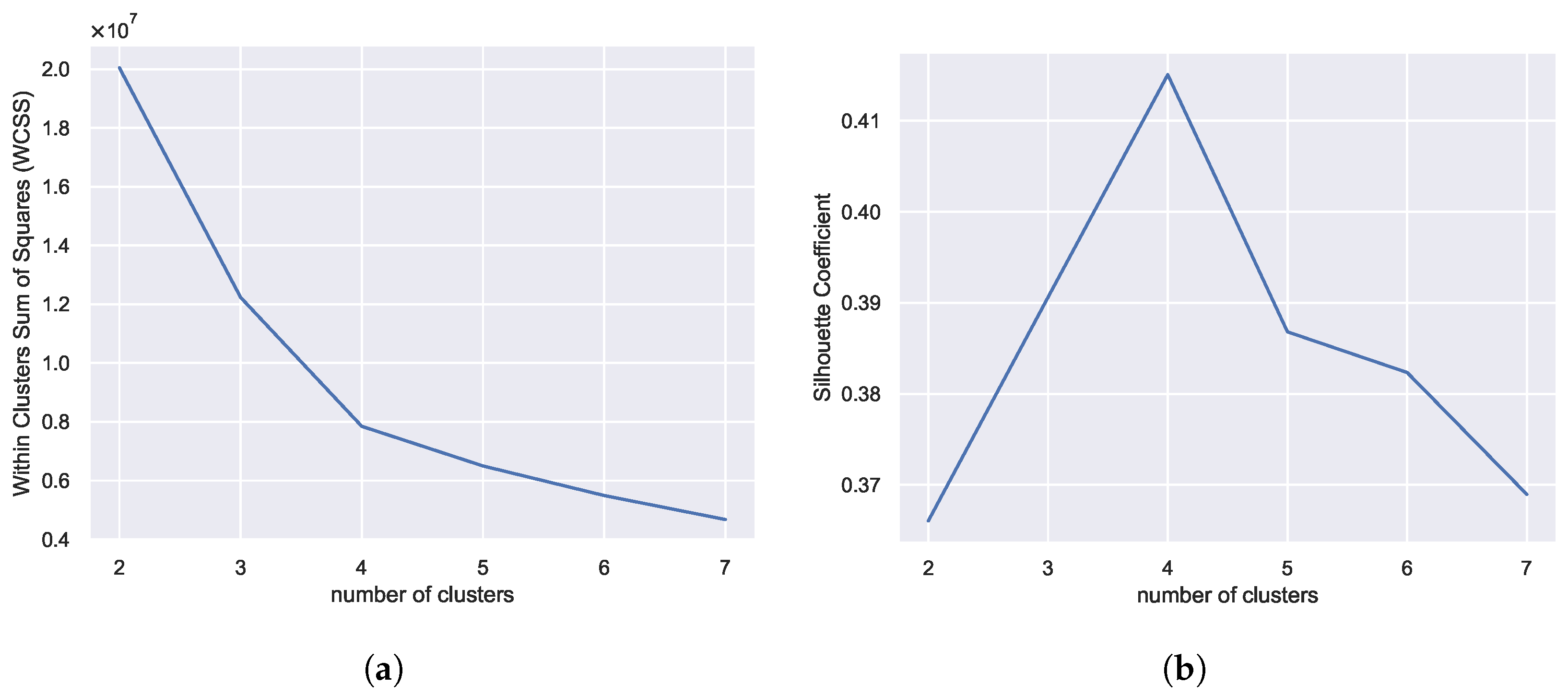
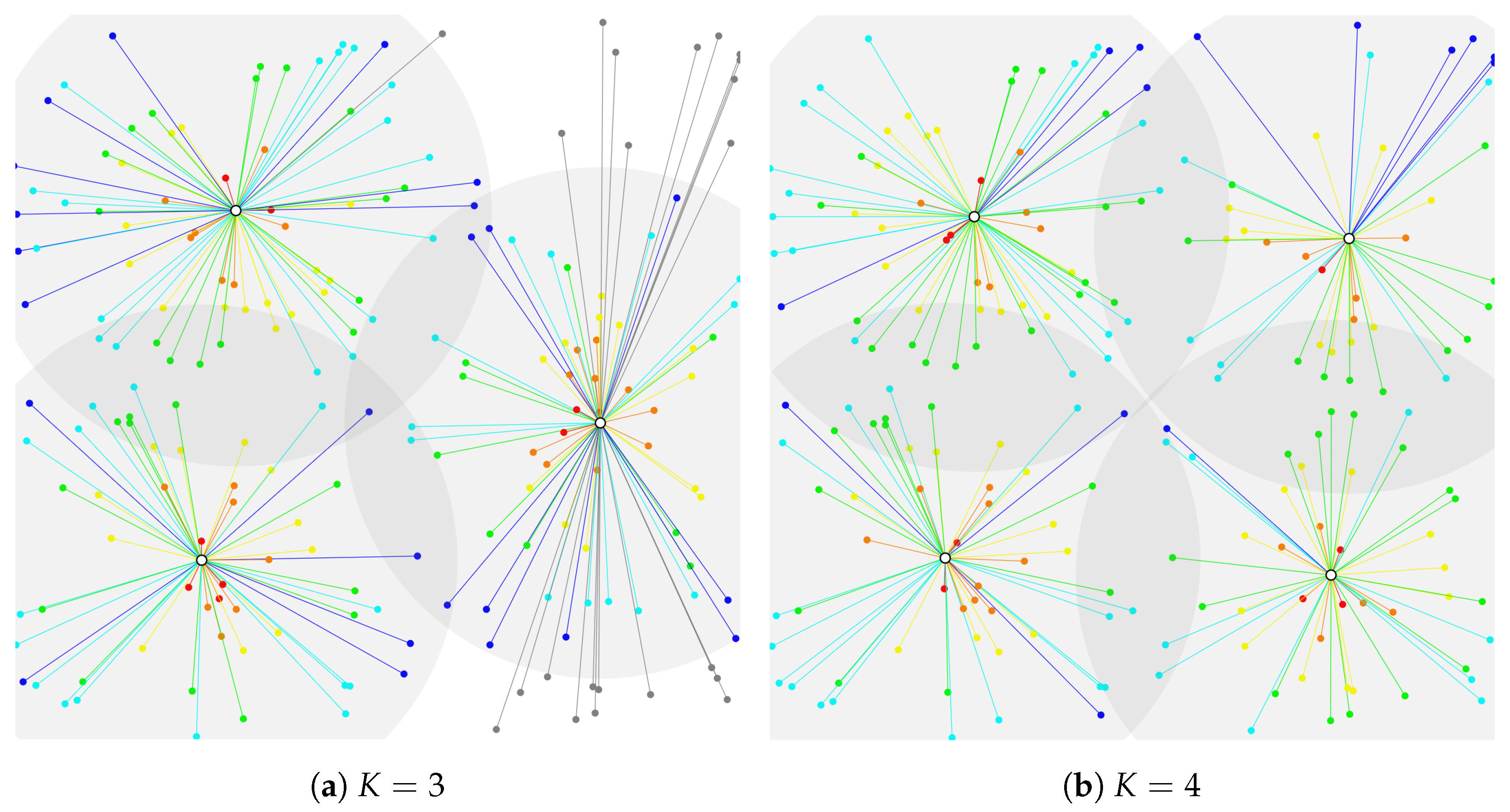

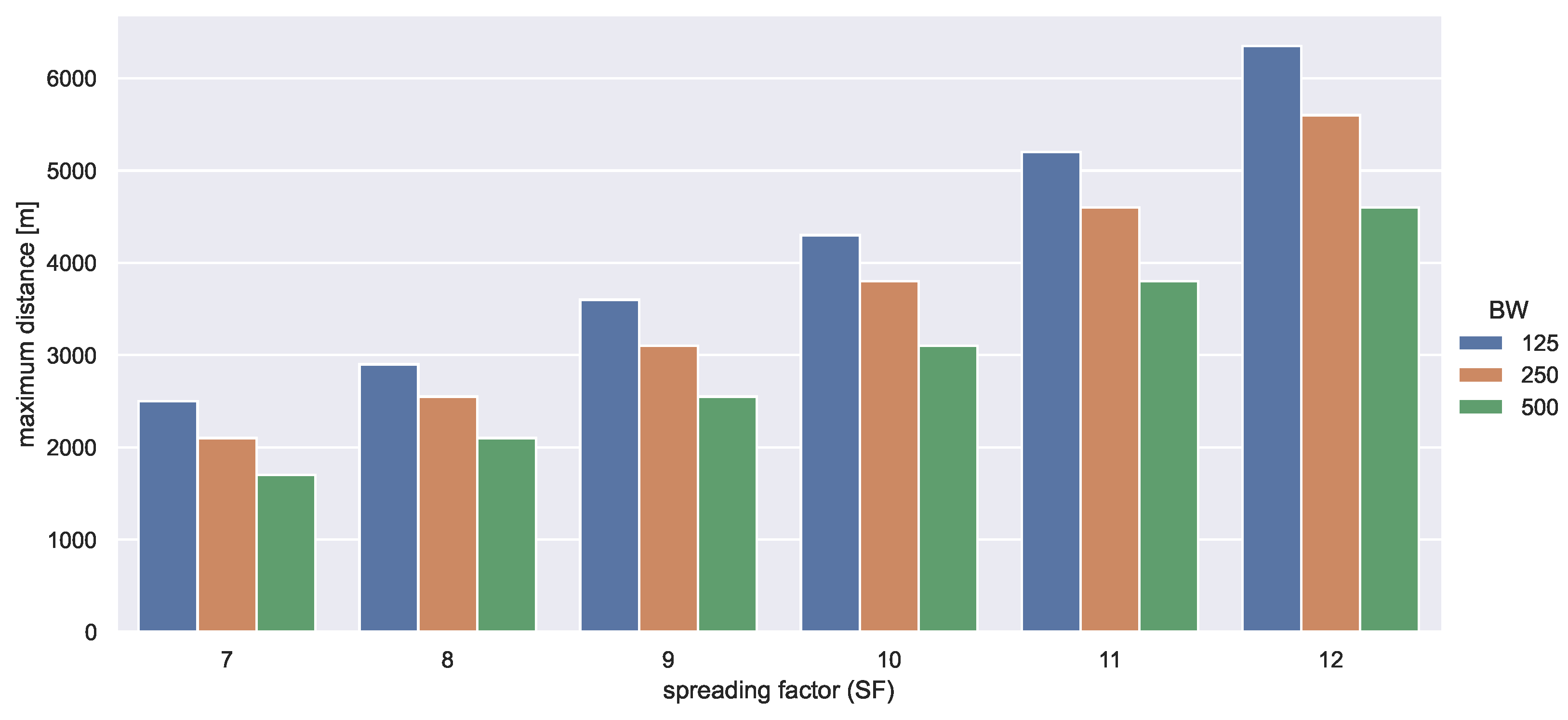
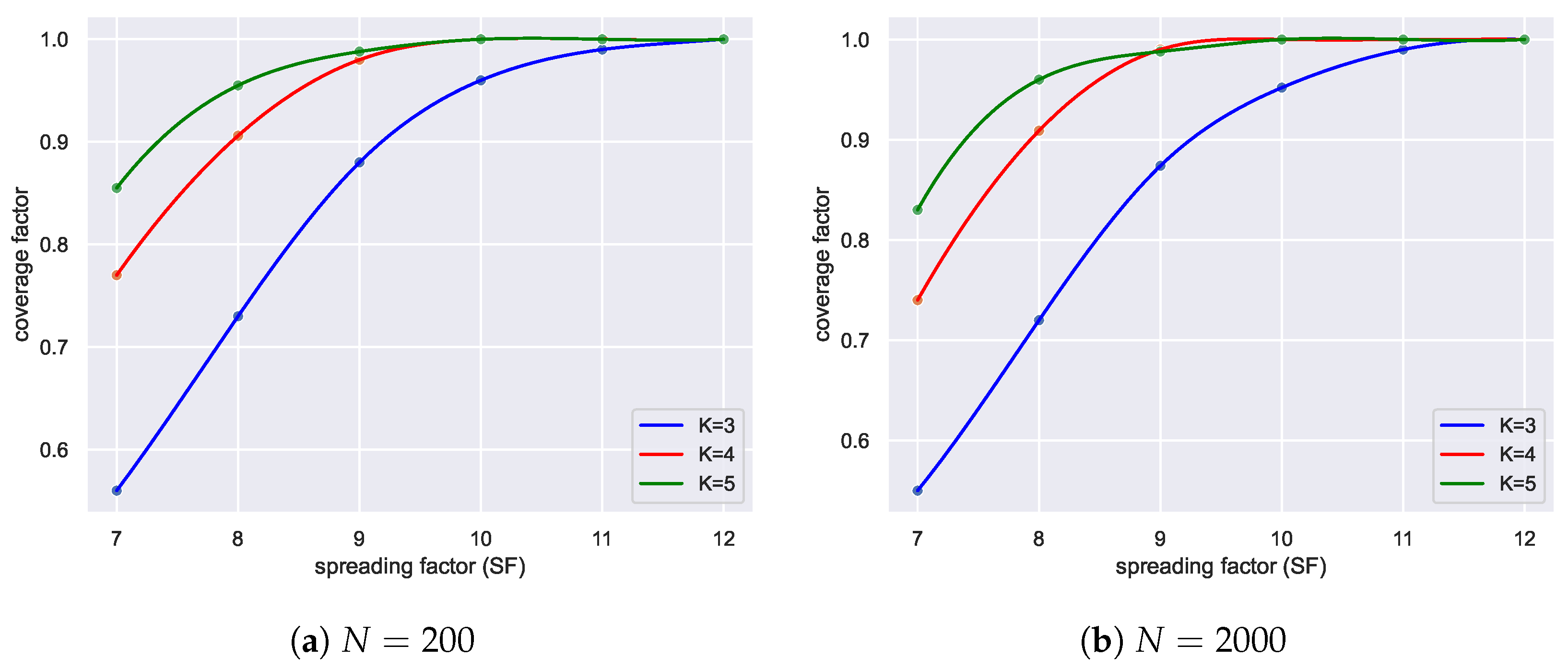
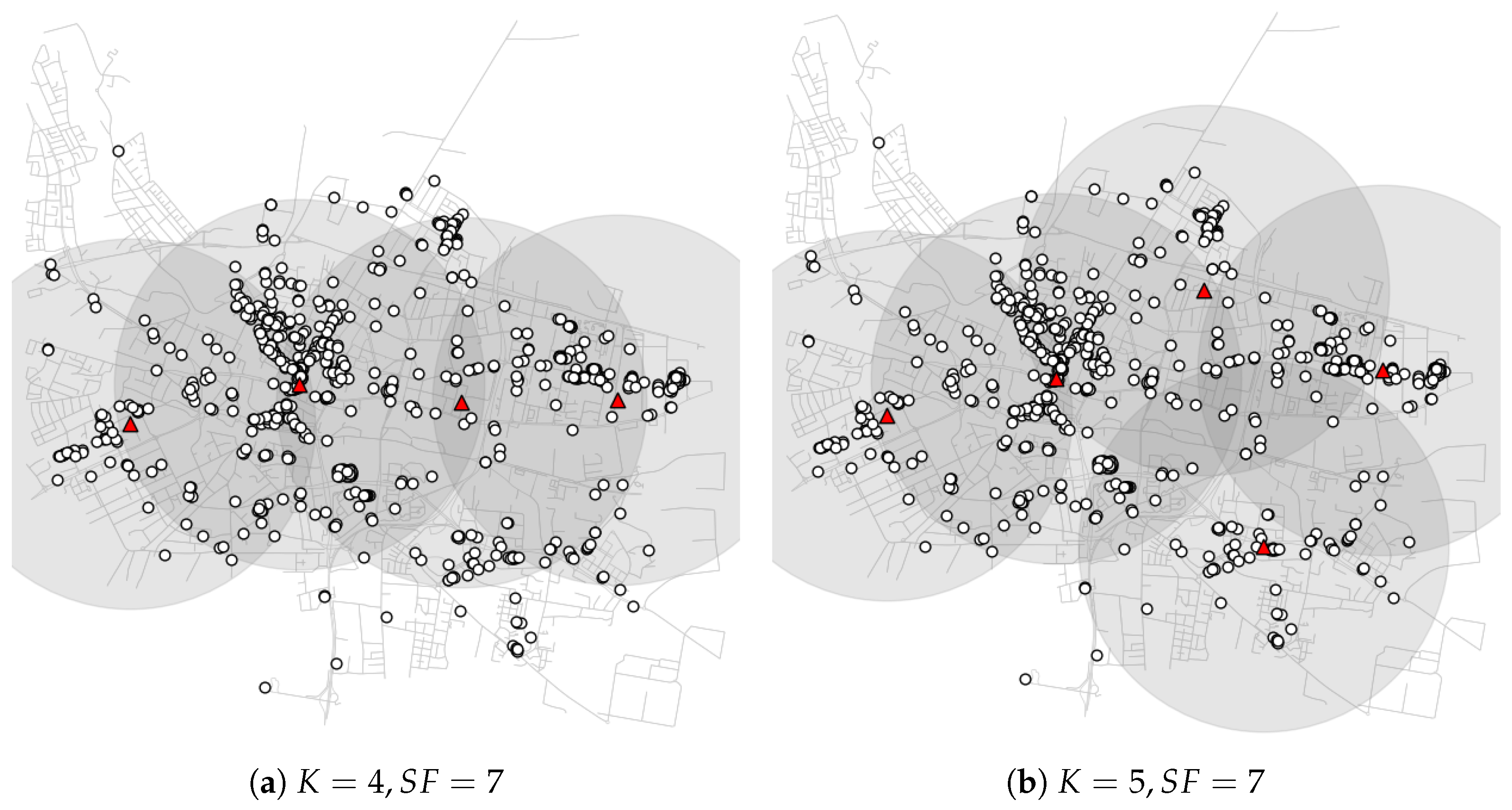
| SF7 | SF8 | SF9 | SF10 | SF11 | SF12 | |
|---|---|---|---|---|---|---|
| 7 | 6 | −16 | −18 | −19 | −19 | −20 |
| 8 | −24 | 6 | −20 | −22 | −22 | −22 |
| 9 | −27 | −27 | 6 | −23 | −25 | −25 |
| 10 | −30 | −30 | −30 | 6 | −26 | −28 |
| 11 | −33 | −33 | −33 | −33 | 6 | −29 |
| 12 | −36 | −36 | −36 | −36 | −36 | 6 |
| BW [kHz] | SF7 | SF8 | SF9 | SF10 | SF11 | SF12 |
|---|---|---|---|---|---|---|
| 125 | −126 | −129 | −132 | −135 | −138 | −141 |
| 250 | −124 | −127 | −130 | −133 | −136 | −139 |
| 500 | −121 | −124 | −127 | −130 | −133 | −136 |
Disclaimer/Publisher’s Note: The statements, opinions and data contained in all publications are solely those of the individual author(s) and contributor(s) and not of MDPI and/or the editor(s). MDPI and/or the editor(s) disclaim responsibility for any injury to people or property resulting from any ideas, methods, instructions or products referred to in the content. |
© 2023 by the authors. Licensee MDPI, Basel, Switzerland. This article is an open access article distributed under the terms and conditions of the Creative Commons Attribution (CC BY) license (https://creativecommons.org/licenses/by/4.0/).
Share and Cite
Piechowiak, M.; Zwierzykowski, P.; Musznicki, B. LoRaWAN Metering Infrastructure Planning in Smart Cities. Appl. Sci. 2023, 13, 8431. https://doi.org/10.3390/app13148431
Piechowiak M, Zwierzykowski P, Musznicki B. LoRaWAN Metering Infrastructure Planning in Smart Cities. Applied Sciences. 2023; 13(14):8431. https://doi.org/10.3390/app13148431
Chicago/Turabian StylePiechowiak, Maciej, Piotr Zwierzykowski, and Bartosz Musznicki. 2023. "LoRaWAN Metering Infrastructure Planning in Smart Cities" Applied Sciences 13, no. 14: 8431. https://doi.org/10.3390/app13148431
APA StylePiechowiak, M., Zwierzykowski, P., & Musznicki, B. (2023). LoRaWAN Metering Infrastructure Planning in Smart Cities. Applied Sciences, 13(14), 8431. https://doi.org/10.3390/app13148431







